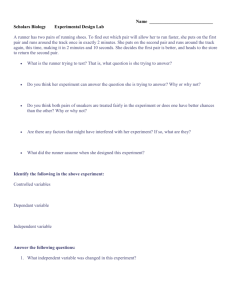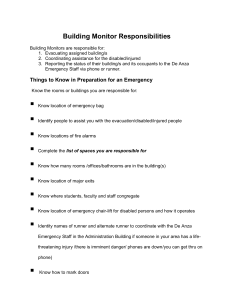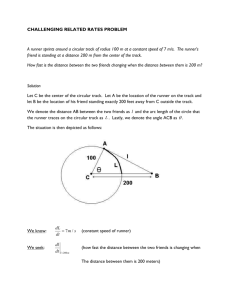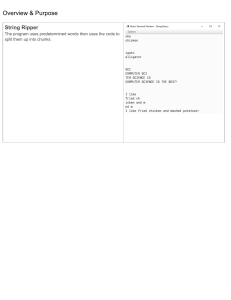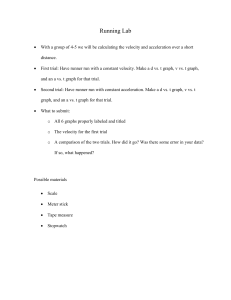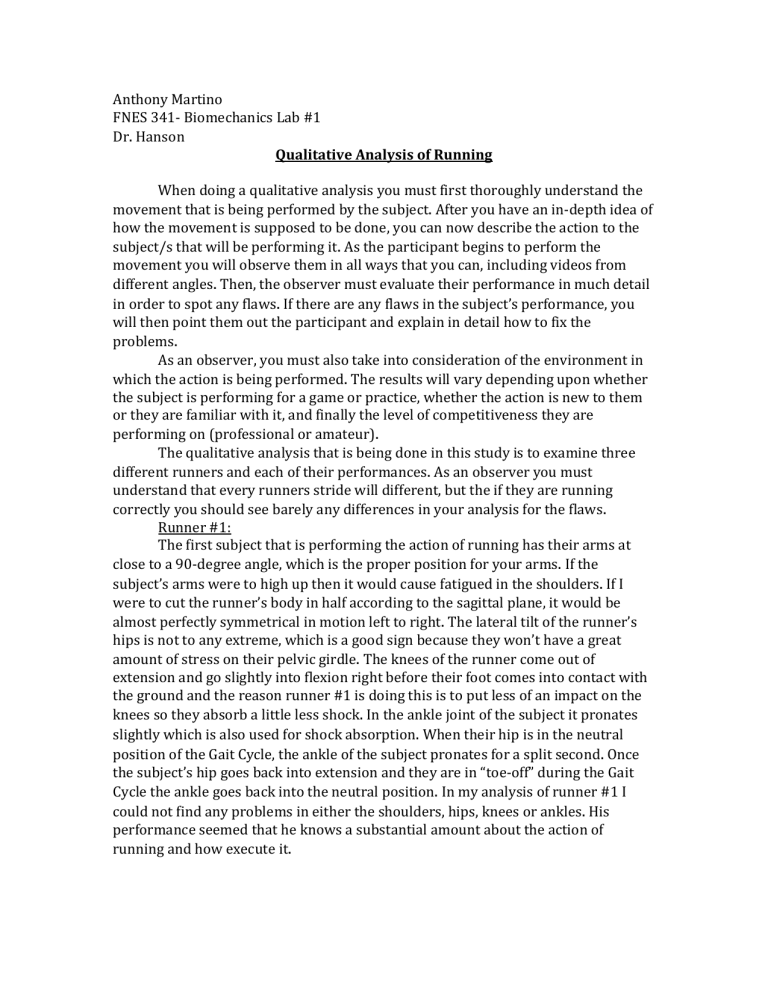
Anthony Martino FNES 341- Biomechanics Lab #1 Dr. Hanson Qualitative Analysis of Running When doing a qualitative analysis you must first thoroughly understand the movement that is being performed by the subject. After you have an in-depth idea of how the movement is supposed to be done, you can now describe the action to the subject/s that will be performing it. As the participant begins to perform the movement you will observe them in all ways that you can, including videos from different angles. Then, the observer must evaluate their performance in much detail in order to spot any flaws. If there are any flaws in the subject’s performance, you will then point them out the participant and explain in detail how to fix the problems. As an observer, you must also take into consideration of the environment in which the action is being performed. The results will vary depending upon whether the subject is performing for a game or practice, whether the action is new to them or they are familiar with it, and finally the level of competitiveness they are performing on (professional or amateur). The qualitative analysis that is being done in this study is to examine three different runners and each of their performances. As an observer you must understand that every runners stride will different, but the if they are running correctly you should see barely any differences in your analysis for the flaws. Runner #1: The first subject that is performing the action of running has their arms at close to a 90-degree angle, which is the proper position for your arms. If the subject’s arms were to high up then it would cause fatigued in the shoulders. If I were to cut the runner’s body in half according to the sagittal plane, it would be almost perfectly symmetrical in motion left to right. The lateral tilt of the runner’s hips is not to any extreme, which is a good sign because they won’t have a great amount of stress on their pelvic girdle. The knees of the runner come out of extension and go slightly into flexion right before their foot comes into contact with the ground and the reason runner #1 is doing this is to put less of an impact on the knees so they absorb a little less shock. In the ankle joint of the subject it pronates slightly which is also used for shock absorption. When their hip is in the neutral position of the Gait Cycle, the ankle of the subject pronates for a split second. Once the subject’s hip goes back into extension and they are in “toe-off” during the Gait Cycle the ankle goes back into the neutral position. In my analysis of runner #1 I could not find any problems in either the shoulders, hips, knees or ankles. His performance seemed that he knows a substantial amount about the action of running and how execute it. Runner #2: As you examine the second subject, you notice that their arms are an angle below 90-degrees, which will cause fatigue in the shoulders. They will also not generate as much speed as they should be able to since their arms are in the incorrect position. The runners hips tilt laterally and excessive amount which will cause more stress and shock to the pelvis and the hip joint. In terms of the Gait Cycle, her knees seem to stay in extension as heel strike occurs and by doing this it cause much stress on the knees overtime. The subjects ankles seem to be in good form with slight pronation during dorsiflexion mid-stance top create a small amount of shock absorption. Subject #2 has three problems in their running cycle, one being that they carries their arms to low which can be fixed by just pumping your arms with a little more force. The other problem is the lateral tilt on their hips; it is tilting the pelvis at a higher angle than it should be. To fix ones lateral tilt control you must stretch one’s hip flexors and tighten back down after the stretch. This is not an easy task because the hip flexors are not muscles that are used consciously everyday. The last problem is knee joints on the subject; they are getting worn down because they are in extension when they hit the floor and she is running flat-footed. To fix this the subject must learn to run on their toes so that way the knee will be in flexion and there will be a shock absorber for the knee joint. Runner #3: The third runner in the examination has their arms at a 90-degree angle but yet the shoulders sway much more than normal in the transverse plain. The abnormal swaying of the upper torso will cause shoulder tension and fatigue in the upper torso. The subject’s hips seem to be in good form in the sagittal plane as well as the knees in terms of Gait. The knee joint is slightly flexed when coming to heel strike, creating a shock absorber for the knees. As for the runner’s ankles, they are over pronating to an extreme amount. This will affect the tibiocalcaneal ligament of the ankle joint by putting large amounts of stress on it. In order to fix the first problem of the subject’s shoulders you must have them move their elbows in. This will prevent the flailing outward motion of their elbows and there won’t be as much twisting in the transverse plane. The second problem is that they over-pronate their ankles on impact and to fix this you have to give them special souls in the shoe that supports supination or you can have them do supination exercises that help control the amount of pronation being stressed. As seen in the experiment, everyone will have a different running motion because nobody is anatomically perfect to another. Runner 1 and Runner 2 had good knee movements but yet runner 2 and runner 3 had bad shoulder movements. Runner 3’s shoulder movements were to a bit more of an extreme on stress than runner 2 but they are both easy fixes. In the analysis it seems that runner 1 was the best out of the three because I could not find any significant problems with them.
